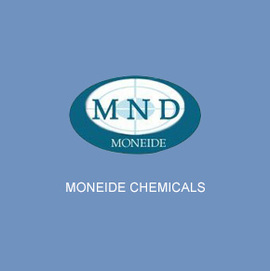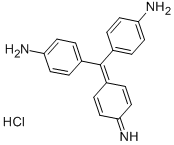Produtos Químicos Moneide
Telefone: 86-315-8309571
WhatsApp/WeChat/Celular: 0086-15633399667
Skype: janet-honesta
Correspondência: sales@moneidechem.com
Endereço: 2-7-523 Jidong Building Materials Tangshan, Hebei 064000 China
Basic Red 9
|
Nome químico |
Basic Red 9 |
|
Sinônimos |
C.I. 42500; Pararosaniline chloride; Basic Fuchsin; 4,4'-(4-Iminocyclohexa-2,5-dienylidenemethylene)dianiline hydrochloride |
|
Fórmula molecular |
C19H17N3.HCl |
|
Nº CAS. |
569-61-9 |
|
EINECS No. |
211-189-6 |
|
Peso molecular |
323.82 |
|
Estrutura Molecular |
|
|
Detalhes |
Appearance:invisible green crystal powder Ignition residue(sulphate): 0.2% max. Sodium sulfite test: passes Loss on drying: 14.6% max. Packing: 1kg/foil bag, 25kg/fibre drum
|
|
Aplicação principal |
Used as Biological stains. |
- Fiber Dyeing: Basic Red 9 is widely used in the textile industry for dyeing different fibers. It can create a unique and attractive color on cotton fabrics, which is popular in the production of clothing, home textiles, and industrial fabrics. For silk, it imparts a lustrous red - green color, enhancing the elegance of silk products. When dyeing synthetic fibers like nylon, it provides good color penetration and fastness, ensuring that the dyed products maintain their color even after multiple washes.
- Textile Printing: It is also used in textile printing processes. The solubility and color properties of Basic Red 9 allow it to be formulated into printing pastes, enabling the creation of intricate and colorful patterns on fabrics. This is commonly seen in the production of fashion garments, upholstery, and decorative textiles.
- Paper Dyeing: In the paper industry, Basic Red 9 is used to color various paper products. It can be added to the pulp during the paper - making process to produce red - green - colored papers for stationery, gift - wrapping papers, and decorative papers. The color is evenly distributed in the paper, resulting in a uniform and appealing appearance. It can also be used in paper printing inks to add a distinctive red - green color to text and graphics.
- Leather Dyeing: Basic Red 9 can be used to dye leather materials. It penetrates the leather fibers well, giving a uniform and long - lasting color. This is useful in the production of leather goods such as handbags, shoes, belts, and furniture upholstery. The dyed leather not only looks attractive but also maintains its color during normal use and handling.
- Staining in Microbiology and Histology: In biological and medical research, Basic Red 9 can be used as a staining agent. In microbiology, it can be used to stain bacteria, making them more visible under a microscope. In histology, it can be used to stain tissue sections to highlight specific structures. However, it should be noted that its use in biological applications requires careful consideration of potential toxicity and appropriate safety measures.
- Basic Red 9 is harmful if swallowed, inhaled, or absorbed through the skin.
- It may cause skin and eye irritation. Prolonged or repeated exposure may have adverse effects on health.
- Some studies have suggested potential carcinogenicity, although the exact risks are still under investigation.
- It is also toxic to aquatic life with long - lasting effects.
- When handling this product, always wear appropriate personal protective equipment, including chemical - resistant gloves, safety goggles, and a lab coat or protective apron.
- Work in a well - ventilated area, preferably under a fume hood, to avoid inhalation of dust or fumes.
- In case of contact with skin, immediately wash the affected area with plenty of water for at least 15 minutes and seek medical advice. If the compound gets into the eyes, rinse the eyes thoroughly with water for at least 15 minutes, lifting the eyelids occasionally, and then seek immediate medical attention.
- Do not eat, drink, or smoke in the area where Basic Red 9 is being used.
- Avoid releasing this product into the environment, especially water bodies.
- Store Basic Red 9 in a cool, dry place, away from direct sunlight and heat sources.
- Keep it in a tightly sealed container to prevent moisture absorption and contact with air, which could potentially affect its chemical properties and color quality.
- Store it separately from incompatible substances such as strong oxidizing agents and acids to avoid dangerous reactions.
What is the basic red 9 dye?
Basic Red 9 is a synthetic cationic dye belonging to the xanthene class, chemically known as Rhodamine B. This fluorescent compound appears as a greenish-red crystalline powder that dissolves in water and alcohol to produce an intense pink-red solution. Its molecular structure features a central xanthene ring with amino groups that become positively charged in solution, enabling strong binding to negatively charged substrates. The dye exhibits remarkable fluorescence under ultraviolet light, emitting bright orange-red light. This property, combined with its excellent photostability, makes it valuable for both coloring applications and advanced scientific uses. The compound maintains stable coloration across a wide pH range and demonstrates good lightfastness in most applications.
What is the advantage of basic red 9?
The primary advantage of Basic Red 9 lies in its exceptional fluorescence properties, offering superior brightness and photostability compared to many other red dyes. Its strong molar absorptivity and high quantum yield enable sensitive detection at very low concentrations, making it ideal for tracing and labeling applications. The dye exhibits excellent water solubility while maintaining good affinity for various substrates, including textiles and biological specimens. Its cationic nature provides strong electrostatic binding to negative surfaces, ensuring colorfastness in staining applications. Additionally, the compound's stability under diverse chemical conditions allows for versatile use across industrial and research applications. These combined optical and chemical properties make it preferable to alternative dyes in many specialized applications requiring both intense color and fluorescence.
What is the use of basic red 9?
Basic Red 9 serves multiple purposes across industrial and scientific fields. In biotechnology, it's widely used as a fluorescent stain for microscopy and flow cytometry to label cells and cellular components. The textile industry employs it for dyeing silk, wool, and paper products, where it produces vibrant pink-red shades. As a tracer dye, it helps visualize water flow patterns in hydrological studies. The compound also functions as a laser dye in certain tunable dye lasers and finds application in security inks due to its distinctive fluorescence. Recent applications include its use in solar cells as a photosensitizer and in forensic science for fingerprint detection. Its dual functionality as both a colorant and fluorescent probe continues to expand its utility in advanced materials and diagnostic technologies.






























